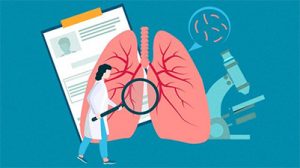Types of Lung Cancer
Lung cancer is primarily categorized into two main types:
- Non-Small Cell Lung Cancer (NSCLC): Accounts for 85% of all cases and is more common and less aggressive than small cell lung cancer (SCLC).
- Small Cell Lung Cancer (SCLC): Less common but more aggressive, often spreading rapidly.
Key Treatments for Non-Small Cell Lung Cancer (NSCLC)
With advancements in medicine, various treatments are available for NSCLC, which include:
- Surgery: Surgical removal of the tumor is often the first-line treatment for early-stage NSCLC.
- Chemotherapy: Used to target cancer cells, often in combination with other treatments.
- Radiation Therapy: Used for localized cancer, often in conjunction with surgery or chemotherapy.
- Targeted Therapy: Focuses on specific genetic mutations in the cancer cells, like EGFR or ALK mutations.
- Immunotherapy: Boosts the immune system’s ability to fight cancer. Drugs like pembrolizumab have shown success in NSCLC patients.
Prognosis for Stage 4 Lung Cancer
Stage 4 lung cancer is often associated with a poor prognosis. However, advancements in treatment have improved survival rates for some patients.
- Five-Year Survival Rate: For NSCLC, the five-year survival rate in stage 4 is around 6%, but this varies depending on individual health and treatments.
- Latest Treatments: Immunotherapy and targeted therapies have contributed to improved outcomes for stage 4 lung cancer patients.
How to Prevent Lung Cancer
Preventing lung cancer is crucial, and there are several lifestyle changes and screening options that can reduce risk:
- Quit Smoking: Smoking is the leading cause of lung cancer, responsible for about 85% of cases.
- Avoid Exposure to Carcinogens: Limit exposure to harmful substances like asbestos, radon, and certain chemicals.
- Healthy Diet and Exercise: A healthy lifestyle can boost your immune system and lower cancer risk.
- Regular Screenings: High-risk individuals, especially smokers, should undergo annual low-dose CT scans for early detection.
Latest Lung Cancer Treatments in the US (2024)
The treatment landscape for lung cancer in 2024 includes new therapies and combinations that target specific cancer types. Here are some of the latest advancements:
- Immunotherapy: Drugs like nivolumab and atezolizumab target the immune system to destroy cancer cells.
- Targeted Therapy: New drugs for EGFR mutations and ALK gene rearrangements, such as osimertinib, have shown promising results.
- Combination Therapy: Combining immunotherapy with chemotherapy or targeted therapy is improving survival rates.
- Minimally Invasive Surgery: Robotic-assisted surgery allows for quicker recovery and less pain.
Q&A Section
Q1: What is the best treatment for non-small cell lung cancer?
A: The best treatment depends on the stage of cancer. For early-stage NSCLC, surgery is often the first-line treatment, while advanced stages may require a combination of immunotherapy, targeted therapy, and chemotherapy.
Q2: How can I prevent lung cancer?
A: The most effective way to prevent lung cancer is to quit smoking. Additionally, avoid exposure to carcinogens, maintain a healthy lifestyle, and undergo regular screenings if you are at high risk.
Q3: What is the survival rate for stage 4 lung cancer?
A: The five-year survival rate for stage 4 NSCLC is around 6%, but newer treatments like immunotherapy have improved survival rates for some patients.
Q4: Are there new lung cancer treatments available in 2024?
A: Yes, new treatments include advanced immunotherapy options, targeted therapies for specific genetic mutations, and minimally invasive surgery techniques that improve patient outcomes.
Q5: How do targeted therapies work for lung cancer?
A: Targeted therapies focus on specific genetic mutations that drive cancer growth. These drugs inhibit the function of mutated proteins, which can slow or stop cancer progression.
Professional Analysis: Lung Cancer Treatment Costs and Survival Rates
Here’s a comparison of common lung cancer treatments, their estimated costs, and their effectiveness based on survival rates.
| Treatment Type | Average Cost (USD) | Five-Year Survival Rate | Common Side Effects |
|---|---|---|---|
| Surgery (Early Stage NSCLC) | $40,000 – $60,000 | 50% (Stage 1) | Pain, fatigue |
| Chemotherapy | $10,000 – $200,000 | Varies by stage | Nausea, hair loss |
| Immunotherapy (e.g., Keytruda) | $100,000+ per year | 25-30% (Stage 3 and 4) | Fatigue, immune-related issues |
| Targeted Therapy (e.g., EGFR) | $150,000+ per year | Varies by mutation type | Rash, diarrhea |
| Radiation Therapy | $10,000 – $50,000 | Varies by stage | Skin irritation, fatigue |
Lung Cancer Survival Rate: What to Expect
Survival rates for lung cancer vary significantly based on the type, stage, and treatment options available. Below is a breakdown of the five-year survival rates for NSCLC based on stages:
| Stage | Five-Year Survival Rate |
|---|---|
| Stage 1 | 47% |
| Stage 2 | 30% |
| Stage 3 | 18% |
| Stage 4 | 6% |
First-Line Treatment Options Near You
Finding the right treatment for lung cancer often depends on your location and access to specialized care. Searching for “first-line treatment for lung cancer near me” can help you find nearby hospitals and oncologists offering cutting-edge treatments like:
- Surgical Options: Local surgeons specializing in minimally invasive lung cancer surgery.
- Immunotherapy Centers: Clinics offering access to the latest immunotherapy drugs and clinical trials.
- Comprehensive Cancer Centers: Institutions that provide a multidisciplinary approach, combining surgery, radiation, chemotherapy, and immunotherapy.
Final Thoughts
The treatment of lung cancer has come a long way, with new options improving survival rates and quality of life for patients. Whether you’re looking for the best treatment for non-small cell carcinoma or exploring ways to prevent lung cancer, staying informed about the latest advancements is essential.








Recent Comments